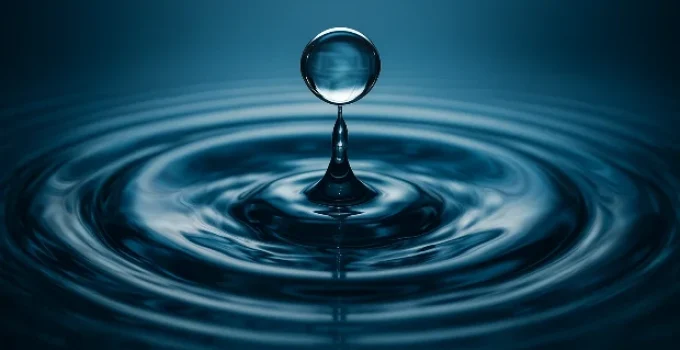Why Does Water Have Surface Tension?
✅ Answer:
Water has surface tension because water molecules stick to each other due to a special force called cohesion. At the surface, these molecules pull tightly together, forming a sort of “skin” that gives water its tension.
🧭 Dive Deeper:
- What Is Surface Tension?
- What Causes Surface Tension in Water?
- The Role of Cohesion and Hydrogen Bonds
- Real-Life Examples of Surface Tension
- Why Surface Tension Is Important in Nature
- How Humans Use Surface Tension
- 🎯 Final Thoughts
- 📚 References
What Is Surface Tension?
Surface tension is the effect where the surface of a liquid acts like a stretched rubber sheet. It happens because molecules at the surface are being pulled in by other molecules below and beside them, but not from above.
This creates a tight layer at the surface of the water that resists being broken.
🧪 Think of it like this:
The top layer of water molecules is clinging tightly together, almost like they’re holding hands to avoid being pulled apart!
What Causes Surface Tension in Water?
The main cause of water’s surface tension is the way its molecules behave.
Water is made of H₂O molecules—two hydrogen atoms and one oxygen atom. These molecules:
- Are polar, meaning they have a slightly positive side and a slightly negative side.
- Are attracted to each other because of this polarity.
This strong attraction pulls the molecules at the surface closer together, making water harder to break through at the top.
📊 Did You Know?
Water has one of the highest surface tensions of all common liquids, second only to mercury [1].
The Role of Cohesion and Hydrogen Bonds
There are two key forces at work here:
- Cohesion:
This is the attraction between molecules of the same substance. In water, cohesion causes molecules to stick to each other. - Hydrogen Bonding:
Water molecules form hydrogen bonds, which are strong attractions between the slightly positive hydrogen atoms and slightly negative oxygen atoms of nearby molecules.
These bonds pull the surface molecules inward, tightening the surface and giving it tension.
🔬 Science Fact:
Hydrogen bonds are weaker than chemical bonds, but they are strong enough to give water its unique behavior [2].
Real-Life Examples of Surface Tension
You’ve probably seen surface tension in action without even realizing it!
- Water beads up on a waxy surface like a leaf or a car hood.
- Insects, like the water strider, can walk on water because their weight doesn’t break the surface.
- Drops of water stay round on a table instead of spreading out flat.
- Paper clips can float on water if placed carefully due to surface tension.
🦟 Cool Stat:
Water striders can support 15 times their own weight on water, all thanks to surface tension [3].
Why Surface Tension Is Important in Nature
Surface tension plays a big role in how plants, animals, and ecosystems work.
- Plants use surface tension to pull water from their roots to their leaves.
- Tiny bugs rely on it to move across ponds and streams.
- It helps raindrops form and stay together as they fall through the air.
Without surface tension, water wouldn’t behave the same way—and life on Earth would change dramatically!
How Humans Use Surface Tension
Surface tension is also useful in technology and science:
- It affects how ink spreads on paper or fabric.
- It helps scientists create small water droplets in medical labs.
- It’s used in cleaning products—soaps lower surface tension, helping water spread and clean better.
🧼 Fun Fact:
Soap and detergent work by breaking surface tension, allowing water to get into tiny cracks and wash away dirt.
🎯 Final Thoughts
So, why does water have surface tension? Because its molecules stick together strongly at the surface, forming a kind of “invisible skin.” This happens due to cohesion and hydrogen bonding—two forces that give water its unique abilities.
From bugs that walk on water to the way plants drink, surface tension is a small but mighty force that shapes the natural world.
📚 References
- U.S. Geological Survey. “Surface Tension and Water.”
https://www.usgs.gov/special-topics/water-science-school/science/surface-tension-and-water - ChemLibreTexts. “Hydrogen Bonding.” https://chem.libretexts.org/Bookshelves/Physical_and_Theoretical_Chemistry_Textbook_Maps/Supplemental_Modules_(Physical_and_Theoretical_Chemistry)/Physical_Properties_of_Matter/Atomic_and_Molecular_Properties/Intermolecular_Forces/Specific_Interactions/Hydrogen_Bonding
- National Wildlife Federation. “Water Striders: The Bugs That Walk on Water.”
https://www.nwf.org/Educational-Resources/Wildlife-Guide/Invertebrates/Water-Striders
📌Learn More About Compound Water (H2O)
- What Is the Boiling Point of Water?💧What Your Kettle Can Teach You About Physics
- Does Water Expand When It Freezes? 💧Ice and Volume Explained
- Why Does Ice Float on Water? 💧 The Surprising Science of Frozen H₂O
- Why Does Water Have Surface Tension? 💧 The Invisible Skin on Every Drop
- Why Is Water Called the Universal Solvent? 💧 The Science of What It Can Dissolve
